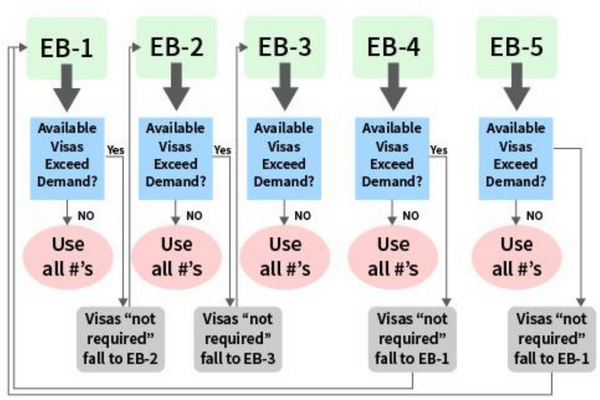
Background for Dates for Filing & Final Action Dates
The US Department of State issues the Visa Bulletin every month. It includes “Dates for Filing” and “Final Action Dates” charts, depending on the month of the year and the movement of priority dates.
In October 2015, the United States Department of State introduced the concept of “Final Action Dates” which is when the green card numbers are available for a country & category. It indicates whether or not it is expected that an immigrant visa number will be available.
“Date for Filing” determines whether or not you can submit the final immigrant visa application, and It is used primarily to prepare ahead by USCIS to make sure there are enough applications in the queue for a fiscal year.
The Visa Bulletin for Oct. 2015, for example, had for the first time two sets of dates for filing family-sponsored and employment-sponsored cases. In each category, there are “Final dates” for each preference and then filing dates for each preference thereby distinguishing between the final date when a visa will be issued and the earliest date when an applicant may file/apply. An AOS applicant may file his AOS based upon the “filing date” and no longer has to wait for the “final date to be available to file.
Fiscal Year 2023 Employment-Based Adjustment of Status FAQ's
Employment-Based Adjustment of Status is the path that many foreign nationals currently living in the U.S. choose to take if they have secured a job at which their employer is willing to sponsor their petition for a green card. The applicant’s employer will need to file a Form I-140, Petition for a foreign worker, with the USCIS and indicate that the applicant will be pursuing adjustment of status. Once this form is approved and a visa number for the applicant’s country of origin is available, he/she will be able to fill out Form I-485, Application to Register Permanent Residence or Adjust Status.
Q1. Can the applicant estimate how many family-sponsored or employment-based immigrant visas USCIS and DOS will use during FY 2023?
Department of Status (DOS) currently estimates that the FY 2023 employment-based annual limit will be approximately 200,000, due to the addition of unused family-based visa numbers from FY 2022 to the employment-based quota for FY 2023. USCIS has committed to employing all available employment-based visas in FY 2023, in collaboration with its DOS partners. USCIS will continue to take numerous proactive initiatives in collaboration with its DOS partners to maximize visa issuance.
Q2. If visas are “not required” in a particular employment-based category, are they made available in the other employment-based categories?
Congress has established statutory provisions that allow visas that are “not required” in certain employment-based categories to be made available to applicants in other employment-based categories. These are known colloquially as the “Fall Down/Fall Up” provisions. Under INA 203, visas not required in EB-4 and unreserved visas not required in EB-5 are made available in EB-1 (b). Visas not required in EB-1 are available in EB-2, and visas not required in EB-2 are available in EB-3. Congress did not include a provision for visas that are not required in EB-3 to be made available in another employment-based category please remember that the EB-5 Reform and Integrity Act of 2022 takes effect on March 15, 2022. Special provisions were passed by Congress to allow some unused EB-5 visas to be carried over from one fiscal year to the next. As a result, not all EB-5 visas in that category that are “not necessary” can be made accessible under EB-1. Here’s a simple visual representation:

Q5. If an applicant is applying for adjustment of status, should they submit Form I-693 with their Form I-485?
USCIS encourages adjustment of status applicants to submit Form I-693, Report of Medical Examination and Vaccination Record, with their Form I-485, Application to Register Permanent Residence or Adjust Status. Doing so will help limit the need for USCIS to send Requests for Evidence, reduce processing times, and aid USCIS as it works with DOS to use all available visas.
Q6. If an applicant did not file a Form I-693 with their pending Form I-485, should they send one in now or wait for USCIS to request it, and why?
Non-citizens with pending status adjustment requests should not send an unsolicited Form I-693. USCIS proactively identifies employment-based adjustment of status applications that lack a valid form. Visiting an attorney will help USCIS use the available visas and adjudicate their application.
Q7. An applicant’s immigrant visa petition has been approved and has a pending adjustment of status application (I-485). What happens next?
When an applicant’s case is forwarded to the Department of State’s National Visa Center (NVC) for pre-processing when USCIS approves their petition. If they have a pending adjustment of status application, a foreign worker converts from non-immigrant to immigrant (permanent) status while remaining in the United States.
After the petition is approved, USCIS proposes to transfer the adjustment of status applications in the first three employment-based preference categories from the Texas Service Center (TSC) and Nebraska Service Center (NSC) to the National Benefits Center (NBC) in the fiscal year 2023. Status adjustment applications will be decided by the Field Operations Directorate.
Q8. If the immigrant visa petition underlines the applicant’s pending adjustment of status application has not been adjudicated, will this prevent them from transferring the basis to a different petition?
If an applicant has a pending petition, that does not prevent them from granting a request to transfer the underlying basis of their pending Form I-485 to a different Form I-140. An applicant’s adjustment of status application pending with USCIS for 180 days or longer, the applicant may request that their application be transferred or “ported” to a qualifying new employment offer.
Q3. Does retrogression affect the applicant’s priority date or place in line for an immigrant visa?
When a non-citizen applies for a visa in a preference category that requires a labor certification from the Department of Labor (DOL), their priority date is usually the date the DOL accepts the labor certification application for processing. For the other employment-based preference categories, the priority date is normally the date the underlying petition is approved for processing by USCIS. Retrogression has no effect on the applicant’s priority date or position in the immigration queue. The applicant may still receive a visa when one becomes available to them based on that priority date. Retrogression simply means that, due to statutory limits, visas are not available to all noncitizens who apply for them, even if the applicants have previously filed an adjustment of status application.
Q4. What is the next step in obtaining a Green Card? When an applicant category was retrogressed or a Final Action Date was applied.
When a visa becomes available to an applicant in the future based on the Final Action Date for their country and category as opposed to their priority date, USCIS will be able to process their adjustment of status application. Applicants are eligible to obtain various benefits while their I-485 application for change of status is pending, including:
- The applicant may apply for employment authorization, and if granted, it is not attached to a specific employer, position, or job classification. It is currently issued in two-year increments.
- The applicant may apply for advance parole, which, if granted, permits them to travel outside the United States during the advance parole validity period and apply for parole into the United States upon their return (at a U.S. port of entry) without abandoning their adjustment of status application.
- If an applicant’s adjustment of status application has been pending with USCIS for 180 days or longer, the applicant may request that their application be transferred or “ported” to a qualifying new employment offer.
- Depending on the specifics of an applicant’s case, their children who have also sought adjustment of status as their derivative beneficiaries may not age out of the ability to do so. While their application is ongoing, the applicant is considered to be “in a period of approved stay” and does not accrue unlawful presence.
Q9. Why must applicants request to transfer the underlying basis of their pending Form I-485? Why does USCIS not review its records and make the decision for the applicants?
- USCIS makes the decision to authorize a transfer request at its discretion. If the USCIS approves the transfer request, they will decide on the Form I-485 application based on the petition to which it was transferred. If USCIS denies the transfer request, they will rule on the Form I-485 application based on the petition submitted with the Form I-485 application prior to the transfer request.
- USCIS does not presume to know whether an adjustment of the status applicant would like to transfer their pending Form I-485 application from the petition on which it is currently based to a different petition. They require transfer requests to be in writing from the applicant to ensure that the record accurately reflects the basis on which the applicant requests the USCIS to adjudicate the adjustment of the status application.
Q10. When does the special exception to the per-country levels for the employment-based categories apply?
If the total number of visas available in one of the employment-based categories for a calendar quarter exceeds the number of qualified immigrants who could otherwise be issued such visas, the visas made available in that category will be issued without regard to the per-country numerical limitation, according to INA 202(a)(5)(A). Depending on the facts, this can happen as early as the first day of a fiscal year.
Q11. When USCIS adjudicates a principal applicant’s adjustment of status application, does USCIS also adjudicate the adjustment of status applications of the dependent family members? What if dependent family members are not approved before priority dates move back?
Although USCIS makes every attempt to adjudicate all the principal and derivative family members simultaneously, this is not always achievable. If USCIS grants clearance for a Form I-485 of a derivative family member but no visa number is available, the case will remain pending until a visa number becomes available, DOS allocates it, and USCIS completes the adjudication.
